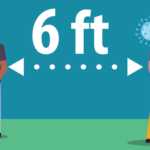Part Two: REOPENING THE RIGHT WAY
\Equipment and Workspace Changes for Post-COVID Business Reopening
COVID-19 has created new expectations for staff and customers in American businesses, and these expectations are going to exist long after COVID is old news. As we begin to reopen workplaces and public spaces around the country, it’s important to secure your business’s future by making sure you’re ready to protect employees and visitors. That means having the right tools to protect your staff, guests, and business. In Part Two of this series, you’ll learn about the supplies and equipment you’ll need to encourage and enforce your new policies and protocols.
Awareness and Instruction
New policies have to be learned by both your staff and your guests. Make the transition easier for everyone by posting signs that will help people navigate new protocols. Remind customers about social distancing and facial covering policies with friendly reminder signs. Direct the flow of traffic with signs to create more space and comfort within your facility. Provide instructions for proper handwashing for both your employees and your visitors.
Social Distancing
Our facilities weren’t designed for social distancing, so a few changes have to be made to allow occupants to stay a safe distance from each other. Consider reconfiguring your office space to achieve maximum habitable area. Once you’ve established the new maximum occupancy for each room (See Part One), you can use door chimes to alert you to entry or exit, which can help with occupant tracking when there’s no attendant.
Barriers can help maintain social distancing in settings that require interaction, such as a cashier station or receptionist’s desk. Floor markers can be used to give each guest space while waiting in line. You may also use barriers between workstations to allow employees to continue to work closely and safely.
Each workspace should be assigned to an individual and shared spaces should be eliminated as much as possible. Common areas that cannot be closed, like break rooms and bathrooms, should be cleaned as frequently as possible. Ideally, you should sanitize common areas after each use. Decommission personal use stations like sinks and urinals to encourage social distancing.
Better Cleaning
Where possible, remove furniture and other surfaces that are difficult to clean. Disinfectants and sanitizers are generally more effective on smooth, nonporous surfaces. Make sure you have the right cleaner for each type of surface you have in your facility. Eliminate clutter that can hide germs so that every surface can be thoroughly cleaned at frequent intervals.
Personal Protective Equipment
Personal Protective Equipment or PPE is the gear you wear to protect yourself against injury and infection. For COVID, PPE includes cloth masks, cloth mask filters, N95 masks, face shields, gloves, and any other coverings for your clothing and person. Your need for PPE will vary depending on the type of business you run, but most American businesses right now will need staff and guests to wear at least a face covering while inside your facility. Improve your customer service by having masks available for customers who don’t have one and instruct your team on the proper use of a mask.
Go Hands-Free
Reducing touch is probably the single most important thing you can do to help stop the spread of COVID. Every facility is different, so you’ll have to take a look in your building or office to identify objects and surfaces that are touched by multiple people throughout the day.
Consider propping open interior doors or removing them entirely to remove the need to touch them. Swap out manual exterior doors for automatic models. Provide single-use and disposable products where possible. Place an attendant at each entrance with a no-touch thermometer to scan both staff and guests as they arrive. Install motion-sensor lighting and get rid of germy manual light switches completely.
In the restroom, install no-touch water faucets and dispensers for soap and paper towels. Choose disposable paper towels instead of air dryers, which have been shown to spread germs around a large area by spreading the water particles. Paper towels trap any remaining germs and take them to the garbage can.
Essential, high-touch areas should be equipped with a sanitizing station that visitors can use before and after touching the shared surface. Get rid of any self-service stations and replace communal refreshment options with individually packaged options.
More Tips
- Keep a 30-day supply of cleaning supplies and PPE to protect yourself from any future public panic purchasing.
- Communicate and post your new policies, maximum capacity, and instructions for your new equipment.
- Keep SDS (safety data sheets) available for all chemicals.


Comments
Part Two: REOPENING THE RIGHT WAY — No Comments
HTML tags allowed in your comment: <a href="" title=""> <abbr title=""> <acronym title=""> <b> <blockquote cite=""> <cite> <code> <del datetime=""> <em> <i> <q cite=""> <s> <strike> <strong>